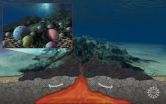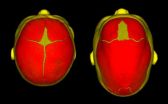(Press-News.org) "Who in his wildest dreams could have imagined that, beneath the crust of our Earth, there could exist a real ocean...a sea that has given shelter to species unknown?"
So wrote Jules Verne almost 150 years ago in A Journey to the Center of the Earth. Verne probably couldn't have imagined the diversity of life that researchers observe today under the ocean floor.
Scientists affiliated with the National Science Foundation (NSF) Center for Dark Energy Biosphere Investigations (C-DEBI) will discuss recent progress in understanding life beneath the seafloor at the American Geophysical Union (AGU) fall meeting, held in San Francisco from Dec. 3-7, 2012.
Once considered a barren plain dotted with hydrothermal vents, the seafloor and the crust beneath it are humming with microbial life--with "dark energy," says Katrina Edwards of the University of Southern California, director of C-DEBI.
Seafloor and subseafloor bacteria not only exist, they're more abundant and diverse than previously thought. The bacteria "feed" on the planet's oceanic crust, posing questions about ocean chemistry and the co-evolution of Earth and life.
"We now know that this remote region is teeming with microbes, more so than anyone guessed," says David Garrison, program director in NSF's Division of Ocean Sciences, which funds C-DEBI.
While scientists have estimated that microbes living in deep ocean sediments may represent as much as one-third of Earth's total biomass, the habitable part of the ocean crust may be ten times as great.
Dark environments appeared to offer little energy for sustaining life. But the abundance of microbes in the subseafloor causes scientists to wonder how long life may have thrived there.
Researchers are working to answer such questions as:
What is the nature of subseafloor microbial communities, and what is their role in the alteration of young ocean crust?
Are these communities unique, especially in comparison with seafloor and sedimentary communities?
Where do microbes in the ocean crust come from--sediment, rock, seawater or another source?
INFORMATION:
C-DEBI-related sessions at AGU include:
InterRidge Session: The Deep Subseafloor Biosphere
Understanding the subseafloor biosphere and its relationship to energy and material fluxes transported by fluid flow has the potential to answer questions about the evolution of life on Earth. This session provides an opportunity to hear results and ideas from various scientific disciplines.
OS13A. InterRidge Session on: Deep Subseafloor Biosphere I Posters
Monday 12/3/12 1:40 p.m. - 6:00 p.m.; Hall A-C (Moscone South)
OS22A. InterRidge Session on: Deep Subseafloor Biosphere II
Tuesday 12/4/12 10:20 a.m. - 12:20 p.m.; 3024 (Moscone West)
OS23B. InterRidge Session on: Deep Subseafloor Biosphere III
Tuesday 12/4/12 1:40 p.m. - 3:40 p.m.; 3024 (Moscone West)
OS24B. InterRidge Session on: Deep Subseafloor Biosphere IV
Tuesday 12/4/12 4:00 p.m. - 6:00 p.m.; 3024 (Moscone West)
The Deep Biosphere: Recent Progress in Understanding Life in the Deep Subsurface
This interdisciplinary session brings together researchers studying the size, distribution, activity and consequence of a microbial deep biosphere in the Earth's subsurface. Scientists involved in recent ocean drilling program expeditions and other deep biosphere programs will take part.
B42C. The Deep Biosphere: Recent Progress in Understanding Life in the Deep Subsurface I
Thursday 12/6/12 10:20 a.m. - 12:20 p.m.; 2004 (Moscone West)
B43G. The Deep Biosphere: Recent Progress in Understanding Life in the Deep Subsurface II Posters
Thursday 12/6/12 1:40 p.m. - 6:00 p.m.; Hall A-C (Moscone South)
InterRidge Session: Fast Moving Research at Slow Spreading Ridges
The range of processes that occurs at slow and ultra-slow spreading ridges has stimulated several multi-national research programs. The findings are relevant for understanding tectonic plate accretion, marine minerals, and chemosynthetic life. With an emphasis on previously overlooked ridge systems in the Northern Hemisphere (Arctic Ridges, Red Sea, Mid-Cayman Rise), and on new findings in the Southern Hemisphere, this session highlights recent results in the geophysical, geological, ocean and life sciences.
OS11E. InterRidge Session on: Fast Moving Research at Slow Spreading Ridges I
Monday 12/3/12 8:00 a.m. - 10:00 a.m; 3011 (Moscone West)
OS12A. InterRidge Session on: Fast Moving Research at Slow Spreading Ridges II
Monday 12/3/12 10:20 a.m - 12:20 p.m.; 3011 (Moscone West)
OS13B. InterRidge Session on: Fast Moving Research at Slow Spreading Ridges III Posters
Monday 12/3/12 1:40 p.m - 6:00 p.m.; Hall A-C (Moscone South)
OS22B. InterRidge Session on: Fast Moving Research at Slow Spreading Ridges IV
Tuesday 12/4/12 10:20 a.m - 12:20 p.m.; 3022 (Moscone West)
'Dark Energy': Life beneath the seafloor discussed at upcoming American Geophysical Union conference
Scientists present recent findings on the subsurface biosphere
2012-11-20
ELSE PRESS RELEASES FROM THIS DATE:
Seattle Children's Research Institute helps identify causes of sagittal craniosynostosis
2012-11-20
Seattle Children's Research Institute, together with an international team of scientists and clinicians from 22 other institutions, have identified two genetic risk factors for the most common form of non-syndromic craniosynostosis, a birth defect in which the bony plates of an infant's skull prematurely fuse. The condition is known as sagittal craniosynostosis and often results in an abnormal head shape and facial features.
The study identified two genes (BMP2 and BBS9) associated with sagittal craniosynostosis that are known to be involved in broader skeletal development.
Results ...
Martian history: Finding a common denominator with Earth's
2012-11-20
Washington, DC — A team of scientists, including Carnegie's Conel Alexander and Jianhua Wang, studied the hydrogen in water from the Martian interior and found that Mars formed from similar building blocks to that of Earth, but that there were differences in the later evolution of the two planets. This implies that terrestrial planets, including Earth, have similar water sources--chondritic meteorites. However, unlike on Earth, Martian rocks that contain atmospheric volatiles such as water, do not get recycled into the planet's deep interior. Their work will be published ...
Faulty development of immature brain cells causes hydrocephalus
2012-11-20
Researchers at the University of Iowa have discovered a new cause of hydrocephalus, a devastating neurological disorder that affects between one and three of every 1,000 babies born. Working in mice, the researchers identified a cell signaling defect, which disrupts immature brain cells involved in normal brain development. By bypassing the defect with a drug treatment, the team was able to correct one aspect of the cells' development and reduce the severity of the hydrocephalus. The findings were published online Nov. 18 in the journal Nature Medicine.
"Our findings ...
CCNY landscape architect offers storm surge defense alternatives
2012-11-20
The flooding in New York and New Jersey caused by Superstorm Sandy prompted calls from Gov. Andrew Cuomo and other officials to consider building storm surge barriers to protect Lower Manhattan from future catastrophes. But, such a strategy could make things even worse for outlying areas that were hit hard by the hurricane, such as Staten Island, the New Jersey Shore and Long Island's South Shore, a City College of New York landscape architecture professor warns.
"If you mitigate to protect Lower Manhattan, you increase the impact in other areas," says Catherine Seavitt ...
New tumor tracking technique may improve outcomes for lung cancer patients
2012-11-20
PHILADELPHIA— Medical physicists at Thomas Jefferson University and Jefferson's Kimmel Cancer Center are one step closer to bringing a new tumor-tracking technique into the clinic that delivers higher levels of radiation to moving tumors, while sparing healthy tissue in lung cancer patients.
Evidence has shown a survival advantage for lung cancer patients treated with higher doses of radiation. Therefore, there is an increased interest to find novel ways to better track tumors—which are in constant motion because of breathing—in order to up the dosage during radiation ...
Multiple sclerosis 'immune exchange' between brain and blood is uncovered
2012-11-20
DNA sequences obtained from a handful of patients with multiple sclerosis at the University of California, San Francisco (UCSF) Medical Center have revealed the existence of an "immune exchange" that allows the disease-causing cells to move in and out of the brain.
The cells in question, obtained from spinal fluid and blood samples, are called B cells, which normally help to clear foreign infections from the body but sometimes react strongly with the body itself. One of the current theories of multiple sclerosis, which strikes hundreds of thousands of Americans and millions ...
Comments, traffic statistics help empower bloggers
2012-11-20
UNIVERSITY PARK, Pa. -- Whether bloggers are writing to change the world, or just discussing a bad break-up, they may get an extra boost of motivation from traffic-measuring and interactive tools that help them feel more connected to and more influential in their communities, according to researchers.
In a series of studies, female bloggers showed that they enjoyed blogging because it made them feel empowered and part of a community, said Carmen Stavrositu, who recently completed doctoral work in mass communications at Penn State. The studies also indicated that the sheer ...
Failed explosions explain most peculiar supernovae
2012-11-20
Supercomputer simulations have revealed that a type of oddly dim, exploding star is probably a class of duds—one that could nonetheless throw new light on the mysterious nature of dark energy.
Most of the thousands of exploding stars classified as type Ia supernovae look similar, which is why astrophysicists use them as accurate cosmic distance indicators. They have shown that the expansion of the universe is accelerating under the influence of an unknown force now called dark energy; yet approximately 20 type Ia supernovae look peculiar.
"They're all a little bit ...
Scripps Research Institute team identifies a potential cause of Parkinson's disease
2012-11-20
LA JOLLA, CA – November 19, 2012 – Deciphering what causes the brain cell degeneration of Parkinson's disease has remained a perplexing challenge for scientists. But a team led by scientists from The Scripps Research Institute (TSRI) has pinpointed a key factor controlling damage to brain cells in a mouse model of Parkinson's disease. The discovery could lead to new targets for Parkinson's that may be useful in preventing the actual condition.
The team, led by TSRI neuroscientist Bruno Conti, describes the work in a paper published online ahead of print on November 19, ...
Astronomers pin down origins of 'mile markers' for expansion of universe
2012-11-20
COLUMBUS, Ohio – A study using a unique new instrument on the world's largest optical telescope has revealed the likely origins of especially bright supernovae that astronomers use as easy-to-spot "mile markers" to measure the expansion and acceleration of the universe.
In a paper to appear in the Astrophysical Journal, researchers describe observations of recent supernova 2011fe that they captured with the Large Binocular Telescope (LBT) using a tool created at Ohio State University: the Multi-Object Double Spectrograph (MODS).
MODS measures the frequencies and intensities ...
LAST 30 PRESS RELEASES:
Novel endocrine therapy giredestrant improves disease-free survival over standard of care for patients with early-stage breast cancer in phase III lidERA trial
Gen Z views world as "scary place" with growing cynicism about ability to create change
Biosensor performance doubled – New applications possible
Leveraging incomplete remote sensing for forest inventory
Key chemical in dark chocolate may slow down ageing
New 15-minute hepatitis C test paves the way for same-day treatment
Uranus and Neptune might be rock giants
Magnetically actuated soft electrodes for multisite bioelectrical monitoring of ex vivo tissues
FAU engineers decode dementia type using AI and EEG brainwave analysis
Carrier-free peptide–daunorubicin–small interfering RNA nanoassembly for targeted therapy of acute myeloid leukemia
Global Virus Network announces appointment of new board members
Artificial beaver dams show promise in offsetting climate change effects
Could hidden infections be fueling long COVID?
Targeted oxygen for initial resuscitation of preterm infants
Researchers develop models to help diagnose ALS earlier through blood biomarkers
Jeonbuk National University researchers develop novel eco-friendly and photo-switchable smart adhesives
Magnetic ordering induces Jahn–Teller effect in spinel-type compounds
A mitochondrial protein may hold the secret to longevity, new study finds
Study shows how everyday repairs sustain autonomy in a Japanese squat
Ancient manatee relative reveals that sea cows have engineered the Arabian Gulf’s seagrass ecosystems for over 20 million years
Fecal tests reveal active termite attacks
Uterine fibroids linked to elevated heart disease risk
Dual use of cigarettes and vapes can reduce risks of smoking and help smokers quit
New bioelectronics device based on hydrogel- elastomer conductive nanomembranes
More yield through heterosis: IPK research team decodes gene interaction
James Webb telescope reveals spectacular atmospheric escape
ICE-CSIC leads a pioneering study on the feasibility of asteroid mining
Dramatic rise in young people using mental health services
Be careful trusting TikTok for gout advice
A study by the University of Seville links the vanishing of the specific heats at absolute zero with the principle of entropy increase
[Press-News.org] 'Dark Energy': Life beneath the seafloor discussed at upcoming American Geophysical Union conferenceScientists present recent findings on the subsurface biosphere




